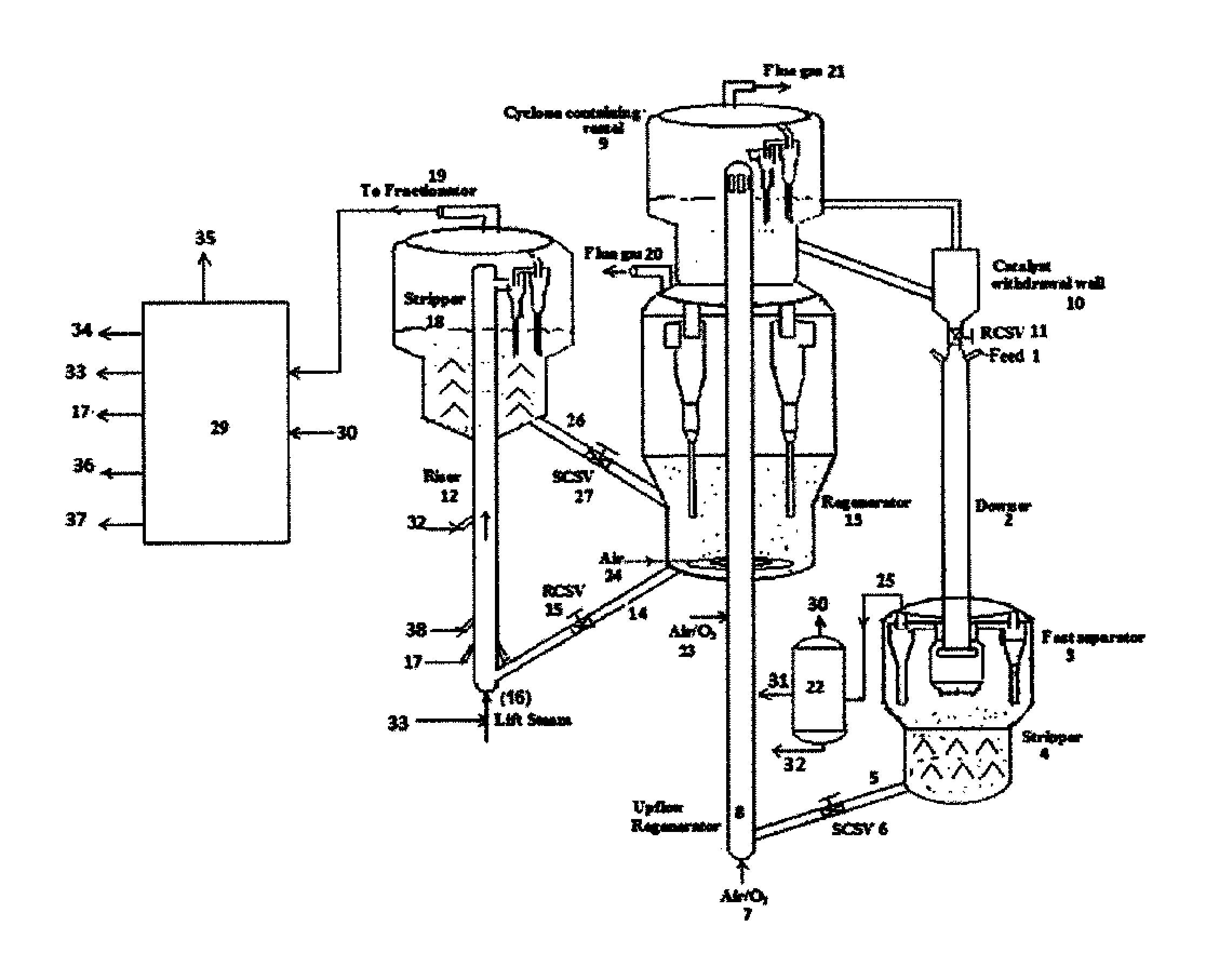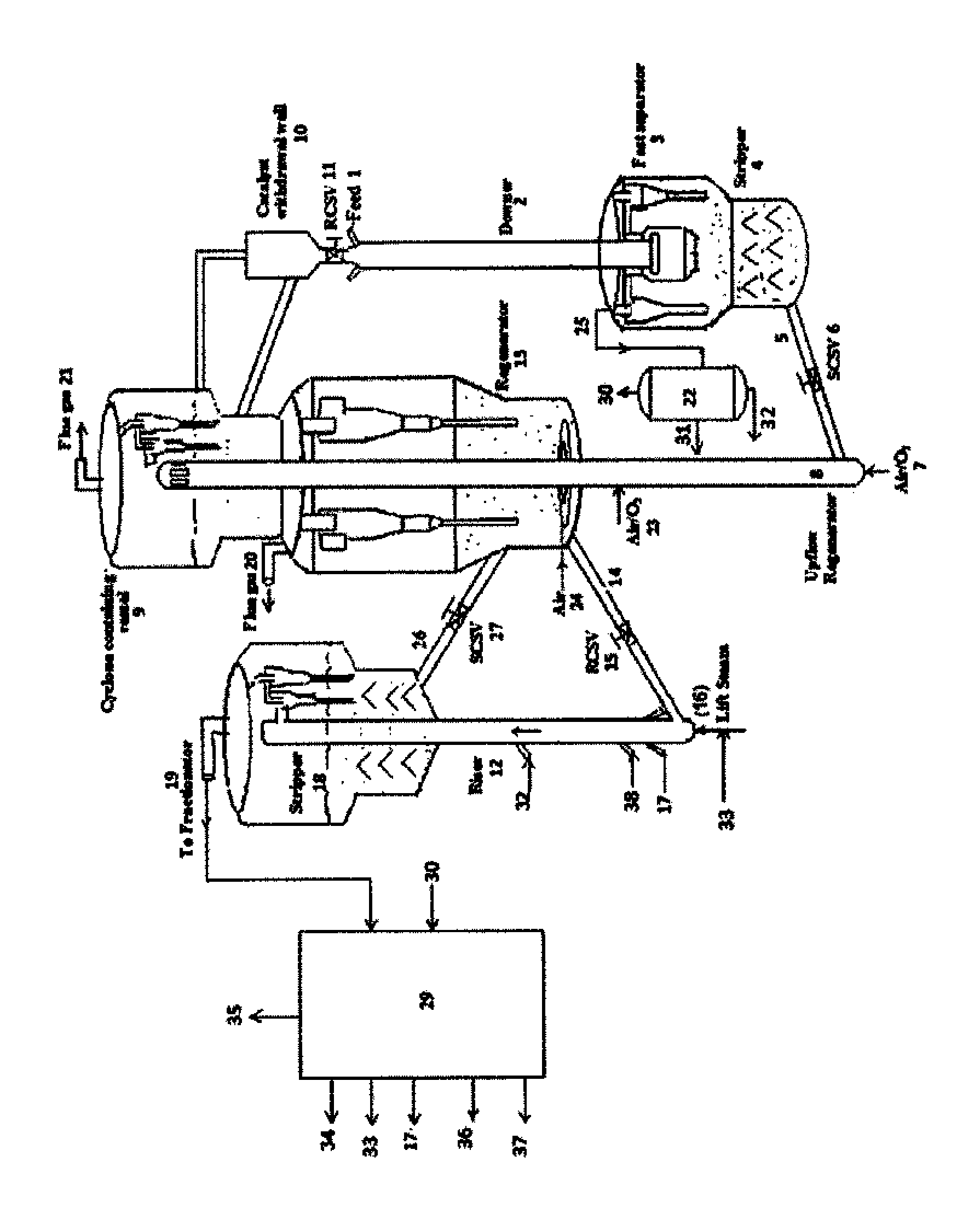Two stage fluid catalytic cracking process and apparatus
a fluid catalytic cracking and fluid technology, applied in catalytic cracking, lighting and heating apparatus, hydrocarbon oil treatment, etc., can solve the problems of reducing the gasoline yield of oil refiners worldwide, affecting the selectivity of middle distillates, and accumulating refractory materials in the system, so as to maximize the light olefins and maximize the selectivity
- Summary
- Abstract
- Description
- Claims
- Application Information
AI Technical Summary
Benefits of technology
Problems solved by technology
Method used
Image
Examples
example 1
[0052]The invented process can be used for the maximization of propylene alone, using a process scheme described as under. Fresh feed is contacted at the entry of the first flow reactor of short contact time with hot circulating catalyst coming from the regenerator, where the cracking reactions take place providing a contact time in the range of 0.2-0.5 seconds. The reaction temperature is around 550-650° C. with catalyst to hydrocarbon feed ratio in the range of 10-35. The first reactor effluent fraction, boiling above 150° C. which are separated using first fractionator and hydrocarbon fractions, naphtha and C4 from second product separation section are passed through the second flow reactor, operating at a temperature of 550-650° C. with a hydrocarbon residence time below 3 sec and catalyst to oil ratio of 10-25. A highly active Y zeolite catalyst containing 5-30 wt % of shape selective pentasil zeolite based catalyst can be used in the first flow reactor, and a highly active Y z...
example 2
[0053]The invented process can be used for the maximization of gasoline alone, using a process scheme described as under. Fresh feed is contacted at the entry of the first flow reactor of short contact time with hot circulating catalyst coming from the regenerator, where the cracking reactions take place providing a contact time in the range of 0.5-1 seconds. The reaction temperature is around 500-580° C. with catalyst to hydrocarbon feed ratio in the range of 515. The first reactor effluent fraction, boiling above 210° C., are separated using a first fractionator, are then passed through the second flow reactor, operating at a temperature of 500-560° C., with a hydrocarbon residence time of 1-3 sec and catalyst to oil ratio of 5-12. REUSY / USY-Zeolite based catalysts with 2-10 wt % of shape selective pentasil zeolite based catalyst can be used in both the flow reactors.
example 3
[0054]The invented process can be used for the maximization of middle distillates alone, using a process scheme described as following. Fresh feed is contacted at the entry of the first flow reactor of short contact time with hot circulating catalyst coming from the regenerator where the cracking reactions take place providing a contact time below 2 seconds. The reaction Temperature is around 450-520° C. with catalyst to hydrocarbon feed ratio in the range of 4-8. The first reactor effluent fraction boiling above 370° C. are separated using a first fractionator are then passed though the second flow reactor, operating at a temperature of 470-530° C., with a hydrocarbon residence time below 5 sec and catalyst to oil ratio of 4-10. A catalyst with high matrix content can be used in the first flow reactor and low active catalyst containing 5-30 wt % of large pore bottom selective active material, can be used in the second flow reactor.
[0055]In one embodiment, a part of the unconverted ...
PUM
| Property | Measurement | Unit |
|---|---|---|
| pore size | aaaaa | aaaaa |
| temperature | aaaaa | aaaaa |
| temperature | aaaaa | aaaaa |
Abstract
Description
Claims
Application Information
 Login to View More
Login to View More - R&D
- Intellectual Property
- Life Sciences
- Materials
- Tech Scout
- Unparalleled Data Quality
- Higher Quality Content
- 60% Fewer Hallucinations
Browse by: Latest US Patents, China's latest patents, Technical Efficacy Thesaurus, Application Domain, Technology Topic, Popular Technical Reports.
© 2025 PatSnap. All rights reserved.Legal|Privacy policy|Modern Slavery Act Transparency Statement|Sitemap|About US| Contact US: help@patsnap.com


